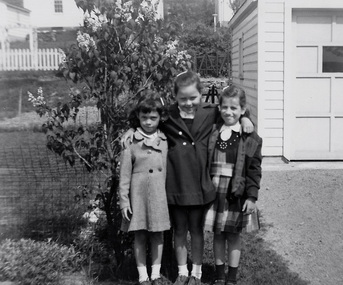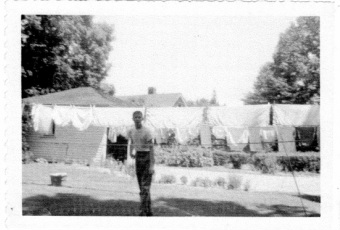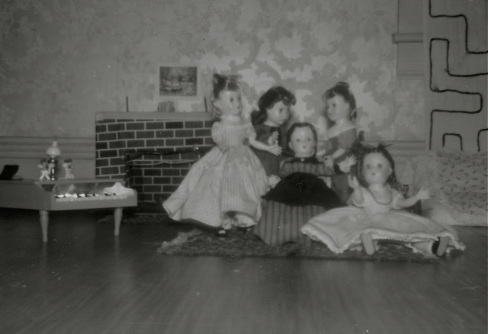Exercise 6: The Story Behind that Photo
Most of us have a box or two of photos and other memorabilia stashed away at the back of the closet. Rarely do we pull them out. But these items are gold for the memoirist, rich with stories laying untouched at the bottom of one's brain, heavy with forgotten details, and loaded with imagery and feeling. So dig in. In this lesson you'll learn how to use the stuff you've saved to generate stories and sketches from the past. The method works well for both photos and other types of memorabilia--dance programs, a bit of balloon, a political button, a twisted spoon, a stack of birthday cards--but let's start with photos.
Spend some time looking through what you have and choose several photos from the past. Don't bother with formal portraits, however, look for old snapshots, particularly those showing both familiar people (yourself included) and some familiar objects or scenes in the background--a car you remember, the neighbor's house, the fence you helped build, a sandbox you played in. You get the idea. . .
Study that picture for a few minutes. Pretend you are a stranger (or a child) who doesn't know what's important and what's not: look at everything in the photo--the people, their clothing, and all of the stuff in the background too. Begin to ask yourself questions. Who are these people? How were they related to you? What were you doing when this picture was taken? Who took that picture? When? Why? Is there anything remarkable or peculiar about the expressions or the clothes or hair of the people? If your photo is black and white, can you remember anything about the colors? Speculating at this point is okay. Now look at background in the same way; ask yourself the child-like questions--this is where you may find real gold. Allow the memories to wash over you and jot down whatever comes to mind. Write down any phrases occur to you, or snippets of dialog. When you've exhausted your memories, put the photo aside. Review your notes. Add to them if you think of something else, and choose just one of the many stories "hidden" in that photo to write it in one, two, or three paragraphs. This time don't let yourself make a lot of associations; try to stay focused on just the one story you've chosen.
Spend some time looking through what you have and choose several photos from the past. Don't bother with formal portraits, however, look for old snapshots, particularly those showing both familiar people (yourself included) and some familiar objects or scenes in the background--a car you remember, the neighbor's house, the fence you helped build, a sandbox you played in. You get the idea. . .
Study that picture for a few minutes. Pretend you are a stranger (or a child) who doesn't know what's important and what's not: look at everything in the photo--the people, their clothing, and all of the stuff in the background too. Begin to ask yourself questions. Who are these people? How were they related to you? What were you doing when this picture was taken? Who took that picture? When? Why? Is there anything remarkable or peculiar about the expressions or the clothes or hair of the people? If your photo is black and white, can you remember anything about the colors? Speculating at this point is okay. Now look at background in the same way; ask yourself the child-like questions--this is where you may find real gold. Allow the memories to wash over you and jot down whatever comes to mind. Write down any phrases occur to you, or snippets of dialog. When you've exhausted your memories, put the photo aside. Review your notes. Add to them if you think of something else, and choose just one of the many stories "hidden" in that photo to write it in one, two, or three paragraphs. This time don't let yourself make a lot of associations; try to stay focused on just the one story you've chosen.

For example:
Here are notes I made on a snapshot from my own box of pictures.
- Me on the left, Pamela somebody (a school friend I think) in the middle, and Sharon Rosen, my best friend on the block. I was always shortest and in the front line at school.
- Mother probably took the picture. We are in the side yard of our house at 1085 Roslyn Avenue in Akron Ohio. I must have been in second or third grade (check the time-line for dates)
- I'm wearing a brown and white spring coat Mother sewed for me. New? (Probably.) Sharon's plaid was brown and yellow.
- The lilac bush--it was Easter time!--Mom always made me new clothes for Easter. (Must have been new) Shopping at O'Neil's and Polsky's for patterns. The lunch counter in the basement.
- The garage belongs to the Messners (?) next door. This stimulates memories of when we built our garage--not so grand as theirs. Our Studebaker was gray.
- Behind us is the backyard, with Dad's vegetable garden, not yet planted, or at least nothing much up yet. He always planted peas on St. Patrick's Day, so maybe they are up a little bit. He grew tomatoes from seeds planted in cut up milk cartons or egg boxes. The south-facing window sills were crowded in early spring. The cold frame Dad built to put out tomato seedlings in the spring (don't see it in picture). How it was made. Falling down.
- My bangs (crooked). Hair barretts! We all had them. My hair worries started early.
- The sandy bank behind the garden. . . digging tunnels & playing cars with my brother
- My elementary school (Schumacher) is one block away, it's back side faced the house above our back yard--that annoying picket fence made it impossible to cut through. My route to school. Don't think I ever went in the front door.

Even old faded and blurry photos work well as tools for the memoirist. For example, this one of my brother taken with my Brownie camera around 1958 or '59. My brother was six years older. We played a lot of badminton in our backyard. I hated his ability to spike the birdie; he was so much taller!. In the foreground, the shadow of our huge sycamore tree. Once the neighbor's kitten got stuck up that tree and Mother called the firemen to get it down. They really came (!) and were very kind. This was the Orchard Road house in Akron. I was almost 10 when we moved there from Roslyn Ave--it was a traumatic experience because I also had to change schools in the middle of fourth grade and lost all my friends and my "standing" in the pecking order. Big story there. Laundry hanging: the smell of it, the wind, the clotheslines, family arguments about most efficient way to hang shirts and trousers, Grandma's sheets freezing outside in the wintertime, her mangle. My dad's garden along the drive (he always! had a vegetable garden). Because he had less backyard space on Orchard Road, he built trellises for everything over the summer. There are no trellises in this picture so it must be early in the season. Our two car garage: we had only one car; my brother housed his reptile cages in the other side of the garage, he had about 2 dozen of them, some for snakes and frogs he caught, but he also ordered creatures through the mail--once a horny toad--and raised mealy worms/bugs?, less slimy to handle than earthworms. The cats liked to sit on top of the cages. Garter snakes stunk on your hands. Mr. and Mrs. Reifsnyder lived beyond the hedge. Mr. Riefsnyder used to take me horseback riding, taught me to use spurs to keep the horse from returning to the barn. I didn't like trotting, but galloping through a meadow was wonderfully. My cowboy boots.

I'm sure you are getting the idea. These photos each contain the seeds of several different stories from my childhood, stories I haven't thought of for years. So take the time to really look at your photos, whether good, bad or indifferent.
A final offering -- If my brother spent a lot of time with his garage soon, I spent my time with these dolls--Madam Alexander's Little Women dolls. Marmee is in the middle, Beth in front of her, Amy, Jo, and Meg in the back row. I spent hours and hours playing dolls. I had one other friend who was a mad about these dolls as I was. I sewed clothes for them, made furniture (in fact my whole family got involved), and put on scenes from Louisa May Alcott's books, which I memorized. On top of the piano are two tiny china Siamese cats: I collected these little animals too, which were housed in shadow boxes on the the wall of my bedroom. This picture was taken in the big, central library room on Orchard Road--I recognize the black and white curtains on the right, which Mother made out of unbleached muslin and black yarn. I remember her groans of frustration as she slowly sewed the yarn with her sewing machine into that angular modern pattern. It was hard to pin properly. Not perfect but they were pretty good.
Now, get out your photos. . . great stories await. Be sure to file your stories as you finish them into your notebook. Also, put your photos and your notes about them into your memory bank. This is where those pocket dividers come in handy. When you feel like writing another story for your memoirs, you can choose a different story behind the photo. Also, you may want to illustrate your final product with one or more of these photos, so keep them handy.
A final offering -- If my brother spent a lot of time with his garage soon, I spent my time with these dolls--Madam Alexander's Little Women dolls. Marmee is in the middle, Beth in front of her, Amy, Jo, and Meg in the back row. I spent hours and hours playing dolls. I had one other friend who was a mad about these dolls as I was. I sewed clothes for them, made furniture (in fact my whole family got involved), and put on scenes from Louisa May Alcott's books, which I memorized. On top of the piano are two tiny china Siamese cats: I collected these little animals too, which were housed in shadow boxes on the the wall of my bedroom. This picture was taken in the big, central library room on Orchard Road--I recognize the black and white curtains on the right, which Mother made out of unbleached muslin and black yarn. I remember her groans of frustration as she slowly sewed the yarn with her sewing machine into that angular modern pattern. It was hard to pin properly. Not perfect but they were pretty good.
Now, get out your photos. . . great stories await. Be sure to file your stories as you finish them into your notebook. Also, put your photos and your notes about them into your memory bank. This is where those pocket dividers come in handy. When you feel like writing another story for your memoirs, you can choose a different story behind the photo. Also, you may want to illustrate your final product with one or more of these photos, so keep them handy.